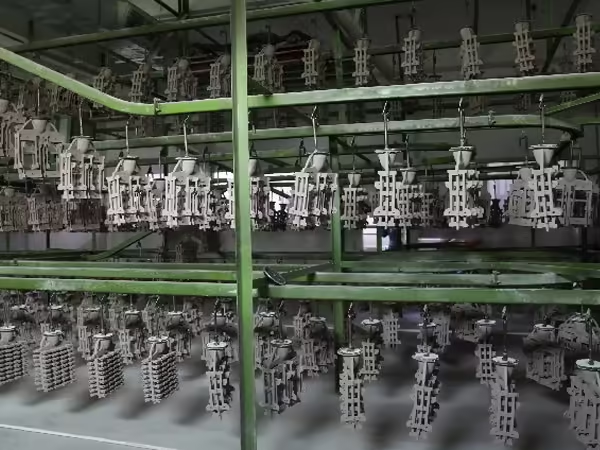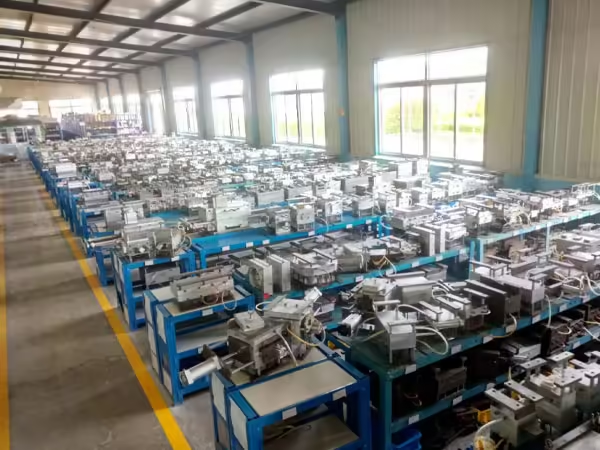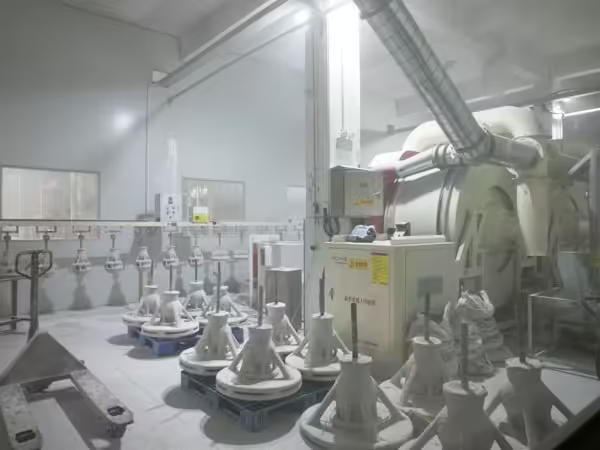10 bewährte Methoden zur Verbesserung der Oberflächenqualität bei Feingussteilen
Inhaltsverzeichnis
Einführung

In der Fertigungs- und Maschinenbaubranche sind Feingussteile zu einer wichtigen Lösung für die Herstellung komplexer Hochleistungskomponenten geworden. Kunden aus Branchen wie der Luft- und Raumfahrt, der Automobilindustrie, der Medizintechnik und der Energiebranche verlangen nicht nur Maßgenauigkeit, sondern auch eine gleichbleibende Oberflächenqualität. Während häufig viel Wert auf die Auswahl der Legierung, Toleranzen und Bearbeitungsmöglichkeiten gelegt wird, ist die Oberflächenqualität von Feingussteilen ebenso wichtig. Sie beeinflusst direkt die Leistung, die Kosten der Weiterverarbeitung und die Langlebigkeit der Teile.
Dieser Artikel untersucht zehn bewährte Methoden zur Verbesserung der Oberflächenqualität von Feingussteilen. Dabei stützt er sich auf anerkannte Standards, Produktionsprozesse und käuferorientierte Erkenntnisse. Am Ende verstehen Sie, wie sich die Oberflächenqualität auf Kosteneffizienz, Funktionsleistung und allgemeine Wettbewerbsfähigkeit in anspruchsvollen Märkten auswirkt.
Warum die Oberflächenqualität wichtig ist Feingussteile

Die Oberflächenqualität ist nicht nur ein ästhetisches Merkmal, sondern ein technischer Parameter, der die Leistungsfähigkeit eines Bauteils bestimmt. Schlechte Oberflächen können Spannungspunkte verursachen, die Reibung erhöhen oder eine kostspielige Nachbearbeitung erfordern. Eine glattere Oberfläche hingegen reduziert den Luftwiderstand, sorgt für eine bessere Verschleißfestigkeit und minimiert die Nachbearbeitung. Für Käufer bedeutet dies niedrigere Gesamtbetriebskosten und weniger Leistungsrisiken.
Internationale Standards für Oberflächenqualität in Feingussteile
Industriestandards spielen eine zentrale Rolle bei der Festlegung von Erwartungen an die Oberflächenqualität. Internationale Organisationen wie ISO, ASTM und SAE legen Parameter für akzeptable Rauheitsgrade fest. Käufer bewerten Gussteile häufig anhand von Ra-Werten, die die durchschnittliche Oberflächenrauheit darstellen.
Zu den gängigen Standards gehören:
- ISO 1302: Definiert die Oberflächenstruktur und Messmethoden.
- ASTM A802: Gibt die Oberflächenrauheitsgrade für Stahlgussteile an.
- SAE AMS 2175: Wird häufig in Gussteilen für die Luft- und Raumfahrtindustrie verwendet, um optische Mängel und Oberflächenfehler zu erkennen.
Für Feingussteile schaffen diese Standards eine gemeinsame Sprache zwischen Lieferanten und Käufern und stellen sicher, dass vertragliche Vereinbarungen zur Oberflächenqualität messbar und durchsetzbar sind.
Wie Wachsmuster die Oberflächenqualität beeinflussen in Feingussteile
Der Weg zu einer hohen Oberflächenqualität beginnt mit dem Wachsmodell. Da es sich beim Feinguss im Wesentlichen um die Übertragung des Wachsmodells in Metall handelt, werden alle Unvollkommenheiten des Modells auf das Endprodukt übertragen.
Glatte, fehlerfreie Wachsmodelle bilden die Grundlage für hochwertige Oberflächen. Faktoren wie Wachseinspritzdruck, Formtemperatur und Abkühlgeschwindigkeit beeinflussen die Oberflächendetails direkt. Moderne Modellherstellungsverfahren, einschließlich 3D-gedruckter Modelle, sorgen für höhere Konsistenz und minimieren Oberflächenfehler, was letztendlich den späteren Nachbearbeitungsaufwand reduziert.
Die Rolle von Keramikschalen bei der Erzielung glatter Oberflächen
Keramikschalen sind ein weiterer entscheidender Faktor für die Oberflächenqualität. Das Schalenmaterial muss fein abgestuft sein, um Oberflächendetails präzise wiederzugeben und gleichzeitig Rissbildung beim Metallgießen zu vermeiden. Eine hochwertige Schalenkonstruktion eliminiert Oberflächeneinschlüsse und verbessert die Reproduktion komplexer Geometrien.
Schalen mit kontrollierter Durchlässigkeit und gleichmäßiger Beschichtungsdicke fördern zudem eine gleichmäßige Verfestigung, wodurch Oberflächenunregelmäßigkeiten weiter reduziert werden. Für Käufer in der Hochpräzisionsindustrie ist die Angabe der Schalenqualität eine effektive Möglichkeit, eine hervorragende Oberflächenqualität zu gewährleisten.
Oberflächendefekte, die häufig auftreten in Feingussteile

Obwohl Feinguss höchste Präzision bietet, ist er nicht immun gegen Oberflächenfehler. Zu den häufigsten Problemen zählen:
- Einbrennfehler verursacht durch eine Reaktion zwischen Metall und Formmaterial.
- Gasporosität Dies führt zu kleinen Vertiefungen oder Löchern auf der Oberfläche.
- Schimmelerosion das erzeugt unerwünschte Rauheit.
- Unvollständige Fusion Dies kann zu unebenen Oberflächen oder Kaltverklebungen führen.
Durch die frühzeitige Erkennung dieser Mängel können Korrekturmaßnahmen ergriffen werden, ohne dass unnötige Kosten an die Käufer weitergegeben werden. Regelmäßige Inspektionen und moderne Qualitätskontrolltechniken helfen den Herstellern, zuverlässige Oberflächen zu liefern.
Vorteile einer guten Oberflächenqualität in Feingussteile
Verbesserte Verschleißfestigkeit
Glattere Oberflächen reduzieren Reibung und Verschleiß im Betrieb. Bei Automobil- und Luftfahrtteilen, die wiederholtem Kontakt oder hoher Belastung ausgesetzt sind, verlängert dies unmittelbar die Lebensdauer der Komponenten.
Reduzierte Nachbearbeitungskosten
Feingussteile mit hervorragender Oberflächenbeschaffenheit erfordern weniger Schleifen, Polieren oder Bearbeiten. Dies spart Käufern Geld, verkürzt die Lieferzeiten und reduziert den Abfall.
Verbesserte Korrosionsbeständigkeit
Oberflächenunregelmäßigkeiten dienen oft als Ausgangspunkt für Korrosion. Ein gut verarbeitetes Gussteil ist widerstandsfähiger gegen Umwelteinflüsse und verlängert die Lebensdauer unter anspruchsvollen Bedingungen.
Bessere Ästhetik und besserer Marktwert
In Branchen, in denen es auf das Aussehen ankommt – wie etwa bei Verbraucherhardware oder medizinischen Geräten – steigert eine hochwertige Oberflächenbeschaffenheit den wahrgenommenen Wert und die Wettbewerbsfähigkeit auf dem Markt.
Vergleich der Oberflächengütegrade in Feingussteile
| Oberflächenqualitätsniveau | Durchschnittlicher Ra-Wert (µm) | Typische Anwendungsbereiche | Auswirkungen auf den Käufer |
|---|---|---|---|
| Standardausführung | 6,3 – 12,5 | Allgemeine Maschinenteile | Ausreichend, muss aber möglicherweise bearbeitet werden |
| Verbessertes Finish | 3,2 – 6,3 | Automobil- und Energieteile | Reduziert die Bearbeitung, verbessert den Verschleiß |
| Hochwertige Verarbeitung | 1,6 – 3,2 | Teile für die Luft- und Raumfahrt und Medizintechnik | Hohe Leistung, Kosteneffizienz |
| Ultrapräzises Finish | <1,6 | Verteidigungs- und chirurgische Instrumente | Maximale Haltbarkeit, Ästhetik |
Diese Tabelle zeigt, wie Oberflächenqualitäten mit der funktionalen Leistung und den Branchenanforderungen übereinstimmen. Käufer können diese Tabelle als schnelle Referenz verwenden, wenn sie Anforderungen in Verträgen oder technischen Dokumenten festlegen.
Kosten-Nutzen-Analyse der Investition in hohe Oberflächenqualität
Hochwertige Oberflächen können zwar die anfänglichen Produktionskosten erhöhen, senken aber oft die langfristigen Kosten. Weniger Bearbeitungsschritte, geringere Ausschussraten und eine verbesserte Haltbarkeit tragen zu Einsparungen über den gesamten Lebenszyklus bei.
Beispielsweise zahlt ein Käufer für Gussteile mit hochwertiger Oberflächenbehandlung 5–101 TP3T mehr, vermeidet aber spätere Nacharbeits- oder Ausfallkosten, die diese Marge um ein Vielfaches übersteigen können. Ganzheitlich betrachtet steigert die Investition in hochwertige Oberflächenbehandlung die Gesamtwirtschaftlichkeit des Projekts.
Anforderungen an die Oberflächenqualität in der Luft- und Raumfahrt Feingussteile
Die Luft- und Raumfahrtindustrie stellt höchste Ansprüche. Turbinenschaufeln, Triebwerksteile und Strukturkomponenten benötigen Oberflächen, die Turbulenzen minimieren, hohen Belastungen standhalten und oxidationsbeständig sind. Bei diesen Teilen können selbst kleinste Oberflächenfehler zu schwerwiegenden Ausfällen führen.
Einkäufer in der Luft- und Raumfahrtindustrie geben häufig enge Ra-Bereiche vor und verlangen eine vollständige Dokumentation der Messergebnisse. Die Oberflächenqualität wirkt sich hier direkt auf Sicherheit, Einhaltung gesetzlicher Vorschriften und langfristige Leistung aus.
Fortschritte bei Keramikschalenbeschichtungen für ein besseres Finish
Jüngste Innovationen in der Schalentechnologie verbessern die Oberflächenqualität weiter. Beschichtungen mit Nanopartikel-Additiven beispielsweise verbessern die Glätte und reduzieren Reaktionen zwischen geschmolzenem Metall und Schalenoberflächen.
Für Käufer bedeutet diese Innovation den Zugang zu Gussteilen mit beispielloser Präzision und reduziert so die Abhängigkeit von Nachbearbeitungen. Branchen, die diese Technologien einsetzen, verschaffen sich einen Wettbewerbsvorteil, indem sie Teile liefern, die mit minimaler Nachbearbeitung montagefertig sind.
So vergleichen Sie die Oberflächenqualität verschiedener Anbieter

Bei der Bewertung von Lieferanten sollten Einkäufer nicht nur Ra-Werte anfordern, sondern auch die Konsistenz über alle Chargen hinweg überprüfen. Wichtige Fragen sind:
- Welche Messmethoden werden zur Überprüfung der Oberflächenbeschaffenheit verwendet?
- Wie häufig wird während der Produktion eine Qualitätskontrolle durchgeführt?
- Wie hoch ist die bisherige Ausschussrate bei Oberflächendefekten?
Anhand dieser Benchmarks können Einkäufer Partner auswählen, die die Oberflächenerwartungen konsequent erfüllen. Lieferantenaudits und Stichprobenprüfungen stärken das Vertrauen in Beschaffungsentscheidungen zusätzlich.
Umweltfreundliche Methoden zur Verbesserung der Oberflächenqualität
Auch in der Gießereibranche gewinnt Nachhaltigkeit an Bedeutung. Umweltfreundliche Techniken wie recycelbare Keramikmaterialien, emissionsarme Wachssysteme und energieeffiziente Polierverfahren werden mittlerweile integriert.
Käufer profitieren davon, dass sie ihre Beschaffungsstrategien an Umweltvorschriften und Nachhaltigkeitszielen des Unternehmens ausrichten können, ohne dabei Abstriche bei der Qualität zu machen.
Abschluss
Die Oberflächenqualität ist ein entscheidender Faktor für Leistung, Kosten und Wettbewerbsfähigkeit von Feingussteilen. Von verbesserter Verschleißfestigkeit über reduzierten Bearbeitungsbedarf bis hin zu erhöhter Korrosionsbeständigkeit bieten hochwertige Oberflächen messbare Vorteile. Durch das Verständnis internationaler Standards, die Bewertung von Prozesskontrollen und die Zusammenarbeit mit Lieferanten können Käufer Gussteile mit langfristigem Wert sichern.
Auf einem globalen Markt, auf dem Präzision und Effizienz wichtiger sind als je zuvor, sind Investitionen in die Oberflächenqualität keine Option, sondern unerlässlich.
Häufig gestellte Fragen
F1. Was ist die typische Oberflächenrauheit für Feingussteile?
Die meisten Feingussteile erreichen Ra-Werte zwischen 3,2 und 6,3 µm, obwohl in der Luft- und Raumfahrt- und Medizinbranche oft Werte unter 1,6 µm gefordert werden.
F2. Bedeutet eine bessere Oberflächenqualität immer höhere Kosten?
Nicht unbedingt. Hochwertige Oberflächen können zwar die Anschaffungskosten erhöhen, reduzieren jedoch Bearbeitungsaufwand, Ausschuss und Ausfallzeiten und senken so häufig die Gesamtbetriebskosten.
F3. Wie können Käufer die Oberflächenqualität überprüfen?
Käufer können Prüfberichte zur Oberflächenrauheit anfordern, unabhängige Inspektionen durchführen oder Werkzeuge wie Profilometer für präzise Messungen verwenden.
F4: Welche Branchen profitieren am meisten von hochwertigen Oberflächen?
Die Branchen Luft- und Raumfahrt, Medizin, Verteidigung und Automobilindustrie sind in hohem Maße auf hochwertige Oberflächen angewiesen, um Sicherheit, Effizienz und Ästhetik zu gewährleisten.
F5. Welche Rolle spielt die Legierungsauswahl für die Oberflächenqualität?
Verschiedene Legierungen reagieren unterschiedlich auf Formen und Veredelungsprozesse. Die Wahl der richtigen Legierung verbessert die Glätte und minimiert die Nachbearbeitung.
Bleiben Sie mit uns in Verbindung

Vielen Dank fürs Lesen! Wir hoffen, dieser Blogbeitrag hat Ihnen wertvolle Einblicke und Inspirationen zum Thema Akustikdecken gegeben. Wenn Ihnen der Inhalt gefallen hat und Sie über die neuesten Trends, Tipps und Einblicke hinter die Kulissen auf dem Laufenden bleiben möchten, würden wir uns freuen, mit Ihnen über die sozialen Medien in Kontakt zu treten.
📘 Folgen Sie uns auf Facebook: Shanghai Leierwo Industriehandel Co., Ltd.
Treten Sie unserer wachsenden Community bei, in der wir Expertenratschläge, Produkthighlights und interaktive Diskussionen mit Fachleuten und Design-Enthusiasten aus der ganzen Welt teilen.
Lassen Sie uns das Gespräch fortsetzen – wir sehen uns dort!
Produktkategorien
- Ventilteile
- Wasserpumpenteile
- Lagergehäuseteile
- Druckgussteile
- Pumpenprodukte aus Edelstahl
- Pumpenprodukte aus Gusseisen
- Ventilteile für den Automobilgebrauch
- Autoteile
- Ventilteile für den zivilen Gebrauch
- Vakuumpumpenteile KF

